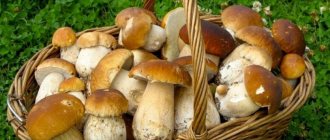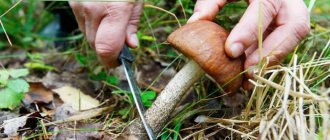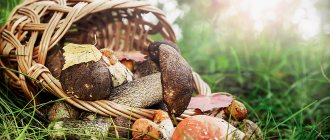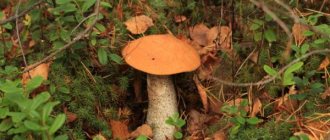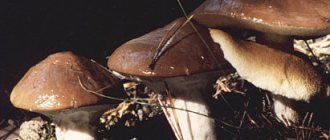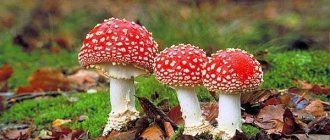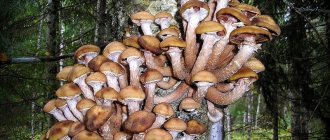Despite the harsh northern climate, the nature of Karelia is very generous. Rivers and lakes are full of fish, and wild animals abound in the untouched forests. More than 270 species of mushrooms grow in local forests.
It will take a lot of time to describe the diversity of Karelian mushrooms. Therefore, we will analyze only the popular edible species - those that local residents collect for themselves. It will also be useful for lovers of “silent hunting” to learn about the season and features of mushroom picking in Karelia.
White mushroom or boletus
It is considered the most noble mushroom and the most desired prey for mushroom pickers. It cannot be confused with toadstool, like other edible mushrooms, and it is good for any processing. Porcini mushrooms can be dried, boiled, fried, salted and pickled. Its peculiarity is its high content of vegetable protein, comparable in value to animal protein.
It is better to look for such mushrooms in Karelia in open clearings in mixed or coniferous forests, where dry soil with sandy soil predominates. The white one grows in groups, so when you find a boletus in the forest, carefully check the area around you - you will probably notice other members of its family nearby.
Collection of porcini mushrooms in Karelia is carried out all summer - from mid-June to the end of August. Usually at the beginning of the season there are few boletus mushrooms in the forest, but by the end of summer their number increases.
Basic rules for picking mushrooms in Karelia
Following safety rules will help you avoid trouble. And get great pleasure from collecting and consuming forest gifts. Experts recommend the following:
- Do not put crops in bags or collect them along roads.
- Avoid unknown or questionable specimens.
- Do not take old, damaged or wormy mushrooms.
- Follow harvesting rules and process the crop immediately after harvest.
- If you find a poisonous mushroom, throw away everything collected.
- Do not give mushrooms to preschool children.
So, a new mushroom season is approaching. And it promises to be impressive. Be sure to go to Karelia for delicious forest gifts! Boletuses, chanterelles, milk mushrooms and many other representatives of the mushroom kingdom are eagerly awaiting beginners and experienced lovers of quiet hunting!
Boletus
A worthy rival to boletus in terms of taste. Boletus is good in any form, but traditionally it is believed that it is better to fry it with new potatoes - this way its rich taste is better revealed. The color of the cap of the boletus varies from bright orange to dark red, the leg is spotted, with oblong black spots.
If the forecast for the mushroom harvest in Karelia does not meet your expectations in the production of boletus mushrooms, then an encounter with boletus mushrooms is more likely. Unlike the porcini mushroom, the boletus mushroom prefers moist soil, so you need to look for it closer to the swamps, in darker places. Boletuses can also be found on dry soils, but much less frequently. They grow in groups, but not as numerous as boletus mushrooms.
Poisonous Karelian mushrooms
Consumption of poisonous mushrooms can lead to gastrointestinal disorders or severe poisoning, even death. The following inedible species grow in Karelia: fly agarics and toadstools, false boletus and false honey mushrooms, cobwebs and bloody tooth.
The bloody tooth has appeared on the territory of the republic since 2007. Its spread began from Finnish lands. To be fatal, simply licking or sitting on a small piece is enough. Most often it can be found near Kostomuksha, in the north, but due to the warming of the summer this year, finds can also be expected in the south of the republic. Under no circumstances should the mushroom be touched or cut with a knife! It has a very distinctive coloring: a white cap with scarlet drops that look like blood.
False butterflies, like false mushrooms, lack a ring on the stem, and the cap is gray at the bottom, not yellow.
boletus
In the Karelian forests there are two types of boletus: common and pinkish. In appearance, they differ from each other only in the color of the cap. You need to look for these mushrooms in dry birch groves or mixed forests. Although pink boletus can also be found in damper areas, in the highlands and tundra, not far from dwarf birches, this does not happen often.
Interesting fact: it is impossible to predict where these mushrooms will go next season in Karelia. Their yield is unpredictable. In the high year, boletus mushrooms literally fill the Karelian forests. But already in the next season they can suddenly disappear, and after a couple of years they can return in even greater numbers.
How is this region different from others?
Karelia is located in the northern part of Russia. This means that humid air predominates in the region, both in summer and winter. From December to February, the weather pleases local residents with moderate frosts, and throughout the summer - warm, but not hot days, maintaining high humidity and a cool breeze. Such unusual, but favorable weather for a good mushroom harvest, promotes favorable growth of both edible and conventional fruits, as well as inedible and poisonous species.
Another advantage of Karelia is the wealth of water resources. In the region, locals know that mushrooms grow best at the border between forest and water. Most often, prey is caught on the shores of lakes and rivers bordering forest belts, coniferous and mixed forests.
The territory is also rich in forest plantations. Karelia is famous for its beautiful and mesmerizing landscapes, occupying more than 80% of the entire area. The list of common trees includes deciduous and coniferous species, as well as mixed forests, which include “mixed type” in their lands.
Local residents have another exceptional feature - they can collect not only mushrooms, but also hazelnuts, cranberries and cloudberries, blueberries and raspberries. They are found entirely close to the interior of the forest and on the outskirts of the forest.
Oil can
There are a lot of subspecies of butter, but the most common one is the real butter dish or the yellow butter dish. By its appearance in the forests you can usually tell whether there are mushrooms in Karelia. If there is an oil can, then other types are more likely to come across.
The mushroom grows in large groups in coniferous forests, prefers sandy soil and bears fruit from mid-summer to late autumn. It was nicknamed the buttercan because in wet weather its cap seemed to be greased with oil due to the mucus formed.
Butterfly is not much inferior in taste to other mushrooms and is good in any form: dried, boiled, fried, salted and pickled. It is easy to digest and is considered one of the most delicious edible mushrooms. When preparing it, it is better to remove the skin from the cap so that the mushroom is not so slippery.
Districts and mushroom places
In 2022, many villages are mushroom spots in Karelia. The first porcini mushrooms began to be collected in the south of the Kola Peninsula. This is despite the fact that they once grew mainly in the northern regions. The same goes for chanterelles: previously these “saffron milk caps” grew only south of Petrozavodsk, but now they are found in the central and western regions of Karelia. The area around Lake Syamozero is full of mushrooms.
Specifically, for example, within a radius of ten kilometers from the village of Syapsya, on the northwestern coast in the village of Chuinavolok. There are also many of them in Vedlozero and Kroshnozero. In general, the entire Pryazhinsky district is a paradise for mushroom pickers. There are a lot of mushrooms in the Loukhi region, especially near Lake Engozero. Many mushroom pickers go to Chalna. If you drive Mashezero on the road to Lososinnoye and follow the dirt road for another two kilometers, you will also come across a “mushroom hotbed”. They grow there almost next to the roadway - get out of the car and collect them.
Material on the topic: Dark honey fungus: a little-known variety of edible honey mushrooms
In the area of the Kutizhma River (the left bank of the Shuya), they say that mushrooms are mowed down with a scythe. And in the Kondopoga region - the village of Girvas, the village of Krasnaya Rechka, Tulguba and Luchevoy - there is a sea of white boletuses, boletus mushrooms. They get tired of collecting them and the smaller ones don’t take them - they are disdainful. There is also darkness in the village of Suisar. To get to Suisary, you need to drive through the villages of Zaozerye and Yalgubu.
Knowledgeable people also advise going to the village of Sopokha, which is nine kilometers from the Kivach waterfall. The area around the reserve is full of mushrooms. If the long road is not scary, then go to the Muezersky district, there are heaps of mushrooms there. For example, you can walk near the village of Rugozero. There are also many mushroom places in the Belomorsky region. Among them are the village of Maslozero, the village of Letnerechensky, and the banks of the Okhta River.
Mushrooms are also collected near Verkhniy Olonets, in the Prionezhsky region, not far from the forest nursery. You can also go to the Segezhsky district, to the village of Nadvoitsy. All around it is a mushroom forest. You definitely won't leave with empty baskets.
Chanterelles
Mushrooms with recognizable shape and color. They grow in large groups, which makes the process of collecting them easier. You need to look for chanterelles in coniferous or mixed forests. There they grow both in open soil and deep in the taiga mosses, under the leaves.
But if you see a bright orange mushroom on a fallen tree, it is better not to cut it off. It could be another mushroom that disguises itself as a real chanterelle - orange talker or false chanterelle.
Those who are interested in whether there are chanterelle mushrooms in Karelia now should pay attention to the month of their planned collection. Chanterelles can be found in forests from June to October. As for the false mushroom, it grows from late summer to late autumn.
Important! The caps of false chanterelles are usually very brightly colored, unlike true chanterelles, which are closer to yellow-orange than red. In addition, these mushrooms differ in the shape of their cap. False chanterelles will have smooth and rounded edges, but a real chanterelle will often have an irregularly shaped cap.
However, the surest sign that helps to distinguish a real fox from a talker is worminess. Insect larvae can only live in false mushrooms, because real ones secrete a special substance - chitinmannose, which kills helminths.
Therefore, if among a group of mushrooms you come across a wormy chanterelle, then this is not the mushroom that you need. In general, false chanterelles are conditionally edible mushrooms. After three days of soaking in water and heat treatment, they can be eaten. However, the taste of such mushrooms will be inferior to the taste of real chanterelles.
Travel around Karelia
There was no purpose here to describe all the mushrooms that grow in Karelia. There are a lot of them. Currently, 272 species and forms of mushrooms have been identified in Karelia, of which 23 species are included in the Red Book. Here are just a few of the most popular, most collected types of mushrooms.
- Mushrooms of Karelian forests
- Poisonous mushrooms
- Mushroom picking
- Harvesting mushrooms for the winter
- Mushroom kitchen
- Mushroom poisoning
- Growing mushrooms
Porcini
The porcini mushroom is found in both lowland and mountain forests - pine, spruce, birch, oak, mixed and even birch bushes. In some places, the boletus appears in May, in others - later and grows until late autumn. But this happens during very bountiful harvests and when cold weather comes unexpectedly, which is why the soil where the mycelium is located does not have time to cool down. The stem of a porcini mushroom is up to 12 or more centimeters in height and up to 6 or more centimeters in diameter. In young ones, the legs are tuberous or ovoid, sometimes cylindrical, then they stretch out, remaining thicker in the lower part. The color of the legs is white or yellowish-brown, with a reticulate pattern, but sometimes only in the upper part. According to the latest data, mycologists count up to 18 forms of porcini mushroom. The following forms are most common in our country. Spruce porcini mushroom. The cap is brown, reddish-brown, chestnut-brown, smooth, dry, occasionally with darker and lighter spots. Grows in spruce and fir forests, as well as in mixed forests with a predominance of spruce trees. White birch mushroom. The cap is light brownish, ocher-yellow or whitish, sometimes almost white. Grows in dry birch forests on clay, loamy and sandy loam soils. White oak mushroom. The cap is brownish with a gray tint, with whitish spots. The pulp is white. Grows in oak forests. White pine mushroom. The large cap is brownish-cherry in color, sometimes with an olive tint. The stalk of an adult mushroom is often tuberous and thick. Grows in pine forests on sandy soil. The porcini mushroom is considered the best and most delicious of all mushrooms. It can be consumed fresh - fried, boiled, pickled and canned and dried in various ways. No matter how the porcini mushroom is processed, its flesh remains the same white, which is probably why it got its name.
boletus
It is often found in forests with birches and birch groves, which is why it got its name. Appears in the first half of summer and occurs until autumn. Boletus mushrooms are also found in the tundra and forest-tundra and next to dwarf birches. The cap is of various colors - from white to dark gray and almost black; at first (in a young mushroom) it is white below, and in an older one it is grayish-brown. In damp places, boletus boletus is more common, with a white or whitish cap surface. The leg is slightly thickened downwards, white, with longitudinal white or dark scales. The pulp is white, the color does not change when broken. In swampy areas, pink boletus is found, with flesh turning pink at the break.
BIRCH ROSE
(Leccinum oxydabile) is usually clearly distinguished from the common birch by the “marbled” color of the cap. Its brown areas alternate with lighter or even white, as well as relatively larger gray scales on the stalk, pinkish flesh at the break, and the formation of fruiting bodies only in autumn. This mushroom grows abundantly in northern damp forests and tundras, as well as in the highlands with one or another type of tree and shrub birch. Known in the north of Western Europe. In Russia it is usually collected and used for food along with common birch.
Gruzd
The real milk mushroom is collected in August-September in forests with birch stands, more often in pine-birch forests, as well as in the mountain forest zone. Milk mushrooms are always found in large groups, or, as mushroom pickers say, “flocks.” In a good year, sometimes you can collect several baskets of them in a small clearing. The cap of the real milk mushroom grows up to 20 centimeters in diameter. Convex at a young age, it then becomes funnel-shaped, with densely fluffy edges turned down. The skin of the cap is white, slimy, yellowish in old mushrooms. The pulp is dense, white. When broken, a white, very bitter milky juice is released, which turns yellowish-greenish in air. The plates are descending, narrow, and frequent. The leg is hollow, the same color as the cap, sometimes paler than it. Real breast milk can only be salted or pickled.
CHEAT BLACK
(Lactarius necator) is distinguished by the following characteristics. Its cap is strong, convex, then broadly funnel-shaped, with a curled hairy edge 5-30 cm in diameter, greenish or dark brown, black, with barely noticeable zones. The pulp is brittle, whitish, and darkens when in contact with air. The milky juice is white, caustic. In humid weather, drops of liquid accumulate on the mushroom cap. The mushroom is edible, it is classified as category 3 and is used for pickling. When salted, the cap takes on a wine-red color. It is found mainly in birch and mixed forests, on sandy and loamy soils. Quite often whole nests. The mushroom is found from July to October.
CHANTERELLE
(Cantharellus cibarius) is known to everyone. Its fruiting bodies can be found in coniferous and mixed forests from west to east of Russia, from Karelia to the Caucasus. The fruiting bodies are egg-yellow, up to 10 cm in diameter and up to 12 cm in height. The fruiting bodies of the chanterelle grow very slowly, especially in dry weather. The mushroom settles in places with underdeveloped grass cover, which is perhaps why it can be found almost only under or near trees. In experiments with artificial infestation (in laboratory conditions), it was established that the chanterelle forms mycorrhiza with pine; in nature, apparently, it can grow in connection with other tree species. Chanterelle is one of the most famous edible mushrooms, used fresh or canned (but not dried or salted). In addition to its pleasant taste, the mushroom is important for its high content of certain vitamins - B1 (no less than in yeast!), PP. The content of microelements (zinc, copper) is no less than that of agaric mushrooms. Successful experiments were carried out on growing mycelium using the deep cultivation method with both cultivated champignon and chanterelle. In this way, you can obtain a valuable food product with high biological productivity. The only obstacle to industrial production for human needs is the lack of specific taste and aroma of “artificial mushrooms.” True chanterelle can be collected from June to the end of autumn in deciduous and mixed forests, and sometimes in coniferous ones, singly and in nests. The chanterelle differs from all mushrooms in its bright egg-yellow color; sometimes the cap and stem are light yellow. At a young age, the cap is convex, hemispherical, but then becomes funnel-shaped, up to 10 centimeters in diameter. The edges of the cap are palmate or lobed-wavy. The plates are sparsely located, the leg is narrowed towards the base. The flesh of the cap and legs is membranous and fleshy and quite tough, elastic, like rubber.
Oiler
The oiler is also called maslyuk, goat.
Varieties of butterdish are known - swamp, gray, granular, late, larch, etc. True butterdish is found in pine forests from July until late autumn, less often in spruce forests, as well as in fires and tugai forests. The butterdish cap is hemispherical, convex in the center, yellow-brown. In dry weather it is shiny, but in damp weather it is slimy, as if lubricated with oil. In a young oiler, the cap is always connected to the stem with a white film, which breaks as it grows, leaving a ring on the stem. The diameter of the cap is rarely more than 8 centimeters. WHITE OIL CAN
(Suillus placidus) is almost white all over;
leg without a ring, usually with reddish or brown warts, almost merging into ridges. Grows with five-coniferous pines. YELLOW OIL CAN
(Suillus luteus) Its cap is brown to yellow in color, sticky;
the tubular layer is finely porous, lemon yellow; leg with an adhesive ring on the outside. It usually grows with double-cone pines, and with Scots pine it goes north to the northern limit of its distribution and in the south to the southern limit. Prefers sparse forests, forest edges, roadsides, etc. The circumpolar species is known in the southern hemisphere in the same pine crops. The granular buttercan
(Suillus granulatus) is very similar to the yellow buttercan, but differs from it in the absence of a ring on the stem.
It grows with double-coniferous pines and in the same places as the yellow one, but it occurs more often and more abundantly on somewhat more calcareous soils and in warmer climates. There is a report that it is occasionally found with five-coniferous pines. YELLOW-BROWN OIL CAN
(Suillus variegaetus) resembles a flywheel, for which it is more often called a yellow-brown flywheel. Its tubular layer is medium-porous, greenish-tobacco-yellow or olive; The flesh is yellowish, turns blue at the break. It grows in pine forests, on sandy soils, often in very large quantities. Known in Europe; in Russia - in the European part, in Siberia and the Caucasus, reaching north to the limit of pine forests, as well as in the mountain forests of Siberia and the Caucasus. Edible (category 3).
Mosswort
Some mushroom pickers call it hare boletus.
The yellow-brown moss is the first to appear in July. It grows mainly in coniferous forests, found in pine forests, and in Altai - in cedar forests. The young mushroom has a hemispherical cap, then it becomes flat, the sharp edges are slightly curved down. The color of the cap is yellow-orange or orange-brown. For some time it is covered with small, fibrous scales. The pulp is loose, light yellow, slightly darker at the break. The size of the cap does not exceed 8 centimeters in diameter. The leg is elongated, dense, yellow-orange in color. Green moss mushroom appears only at the end of summer in mixed forests, in well-lit places, mainly on the edges and near forest roads. The color of the cap is grayish-yellow, grayish-brown with an olive tint. The flesh of the cap is yellow, turning slightly blue in the air. The leg is yellow, and the cap itself is reddish. This flywheel is usually somewhat larger than the yellow-brown one; the cap sometimes reaches 15 centimeters. Young fly mushrooms are eaten fried and boiled; they can be dried and salted. But many mushroom pickers consider flywheels to be low-value mushrooms and do not collect them, especially if there are better mushrooms in the forests at that time. YELLOW FELLOW BASSCYCLE
(Xerocomus chrysenteron) differs from both previous species in having a light or olive green tubular layer and a red stalk. Grows in coniferous and deciduous forests of Europe, North America, Asia (Japan). In Russia, it is more often and abundantly found in oak forests of the southern half of the European part.
Honey fungus
Of the numerous varieties, the most interesting is the true autumn honey fungus; it grows in closely crowded groups on living trunks of coniferous and deciduous trees, as well as on stumps and dead wood.
This honey fungus usually appears in August, sometimes in July, and can be collected until October. The cap of a young mushroom is convex, while that of a mature one is flat, with a tubercle, up to 10 centimeters in diameter. The color of the cap is yellowish-brown or grayish-brown, sometimes reddish in color with dark brown scales. The plates are yellowish-white, but with age they darken and become covered with brownish spots. The flesh of the thin-fleshy cap is white, with a pleasant specific mushroom smell, the taste is sour, astringent. The leg is long, dense, white or gray. In young mushrooms, the cap is connected to the stem by a white film, which breaks off as the mushroom grows and remains hanging in a ring around the stem. Based on this feature, the age of the mushroom is determined. Another honey fungus - the summer one - grows on stumps, rotten logs and other woody remains of deciduous species, but it appears earlier than the autumn one. Summer honey fungus is smaller, its skin is yellow-brown, watery, and the flesh is often brownish. The leg above the ring is brownish, below the ring it is brownish-green. The favorite place of the honey mushroom is dry meadows and forest edges. It appears in June and grows until late autumn, often in large groups. A cone-shaped or flat cap, jagged brownish along the edge, no more than 6 centimeters in diameter. The plates are sparse and pale. The stem is thin, the same color as the cap. This honey fungus is collected mainly in treeless areas. Autumn honey fungus belongs to the third category, and the rest of the mushrooms belong to the fourth category. All of them are eaten both fresh and prepared for future use: they are salted, pickled, dried. Boletus
The cap of the boletus is hemispherical, while that of young mushrooms is like a thimble placed on a finger. Many mushroom pickers call such small boletus boletus mushrooms. You won't find this word in the dictionary. It’s hard to say who invented it and when, but mushroom pickers know it. With growth, the boletus cap straightens, increases in size, and turns into a cushion-convex shape. From hard it becomes fleshy, slightly velvety or fibrous, and more often dry. The caps reach 15 centimeters in diameter, and sometimes even exceed 25. But large mushrooms are usually so old that they are not suitable for consumption. Yellow-brown boletus appears in large numbers from June to October in various forests with aspen stands, on sandy, rocky and peaty soils. The cap is yellow-brown, sometimes fibrous-scaly, but more often smooth and dry. This is the largest boletus; it happens that its cap reaches 30 centimeters in diameter. The pulp is white, dense, turns pink at the break, then becomes purple or gray. The white leg is covered with brown or black-brown scales. All boletuses are consumed fresh, pickled and dried. Aspen boletus (Leccinum aurantiacum) or aspen or red boletus, like birch boletus, has many forms, differing mainly in the color of the cap and its growth with various tree species. A cap with a skin hanging down along the edge, red, orange, brownish, less often yellow or white. The flesh usually turns purple or blue when broken, and eventually turns black. Boletus often grows with aspen, birch, and less often with oak, poplar, pine, and spruce. Distributed in the Old and New Worlds. In the temperate conditions of the northern hemisphere, together with the birch boletus, the boletus is one of the most common and valuable edible mushrooms.
VOLNUSHKA
(Lactarius torminosus) or pink trumpet, or Volzhanka, is distinguished by the fact that its cap in young mushrooms is convex, then wide-funnel-shaped, with a curled fluffy edge, 4-13 cm in diameter, pinkish-red, with clearly defined concentric zones, woolly-fibrous.
The flesh is fawn, pinkish under the skin. The milky juice is sharp, white, and does not change color in air. The plates are yellowish-pinkish, thin. The leg is hollow, one-colored with a cap, at first fluffy, then naked. The mushroom is edible, belonging to the 2nd category. It is used salted. The mushroom is found often and abundantly in mixed forests, in damp forests, sometimes in whole nests. It forms mycorrhiza with birch. It is found from July to October. The white volnushka is smaller, in contrast to the pink one. The cap is up to 5 centimeters in diameter, and its shape is not much different from the pink one. The color of the cap is white or creamy-whitish, without noticeable circles. The leg is hollow, smooth, white. Both volonushki belong to the second category mushrooms and are used only for pickling and pickling. Conical morel
Cap up to 6 cm in diameter and up to 10 cm in height, conical, elongated, less often elongated - ovoid, edges fused with the stem, yellow-brown Morels or gray-brown in color, with a mesh surface reminiscent of a honeycomb, hollow inside. The pulp is white, thin, brittle, fragile, tender, waxy, with a faint pleasant mushroom smell and taste. The spore powder is yellowish. The leg is up to 5 cm high, up to 2 cm thick, cylindrical, smooth or longitudinally folded, hollow, white or yellowish, with a powdery coating.
Grows throughout the forest zone, even in the tundra, in gardens and parks in Central Asia, in mixed, but more often in pine forests on sandy soil, among bushes, in forest clearings, old fires, singly or in groups, in April - May, sometimes in June. Conditionally edible, very tasty mushroom of the third category. In Western European countries it is considered a delicious mushroom. Used dried, boiled and fried. To remove toxic substances, fresh mushrooms are boiled for 15 - 20 minutes, draining the water twice, and dried mushrooms are kept for at least one month before consumption. It is similar to an ordinary stitch, differing from it in the form of a cap - in this case it resembles the convolutions of the brain. It differs from the common morel in its smaller size and conical cap. It has no resemblance to inedible and poisonous mushrooms.
It is worth looking at the following material:
Preparations of cranberries and lingonberries for the winter Berries of Karelia (part 2) Berries of Karelia (part 1) Preparation of mushrooms for the winter
Picking berries in Sweden, practical tips Cloudberry dishes, classic Swedish cuisine Cloudberry jam, classic Swedish recipe
Milk mushrooms
Traditional Russian mushroom. In Rus', milk mushrooms were called the “king of mushrooms”; it was considered the only mushroom suitable for pickling. But in the West, milk mushrooms are still considered inedible.
Real milk mushrooms grow in large groups, but at the same time they are not easy to find, since they are not common. But if you’re lucky, a successful mushroom picker in a good year can carry away up to several buckets of milk mushrooms from one clearing. The harvesting season for these mushrooms is from July to September. You need to look for milk mushrooms in birch or pine-deciduous forests, where they hide in last year’s leaves and needles.
To find out whether mushrooms have grown in Karelia, it is better to talk with local residents. They probably won’t show you the way to the mycelium, but they will definitely tell you about the appearance of mushrooms in the forest, including which ones.
When to go mushroom picking
The first mushrooms appear here in April. These are morels, they can be found in deciduous forests and are recognized by their peculiar bell-shaped “cap”. Due to the content of helvelic acid, morels are classified as conditionally edible. In order to use them for food, you need to boil them and be sure to drain the water. During cooking, the acid remains completely in the broth. In addition, helvelic acid disappears when morels are dried. At the end of spring, oyster mushrooms and puffballs appear.
But the main hunting season for the most valuable summer mushrooms begins in July - August and lasts until the end of September. Boletus mushrooms, boletus mushrooms, russula, fly mushrooms - they can be found in birch and pine forests. There are many chanterelles and boletuses in aspen groves. At the very end of June, noble porcini mushrooms begin to appear. They are hunted in pine forests, spruce forests, and oak groves. They usually have a round, dark-colored cap and a short, fleshy leg. Fresh porcini mushrooms have virtually no odor, but when dried they emit a pleasant aroma. In July, the first milk mushrooms appear and housewives begin to prepare pickles. It is believed that the most delicious mushroom for pickling and marinade is the milk mushroom.
In the spruce forests, mushroom hunters will find saffron milk caps, another species traditionally used for pickling. August gives mushroom pickers everyone’s favorite chanterelles – bright yellow in color with an original cap shape.
Many lovers of “quiet hunting” come to this area in early autumn, when there is a large selection of mushrooms and the weather is conducive to forest travel. Fans of active recreation and walks in the forests choose a holiday in Karelia in early autumn - during this period the leaves on the trees play with all their colors and you can enjoy the unique landscapes of the northern forests in the early autumn period.

